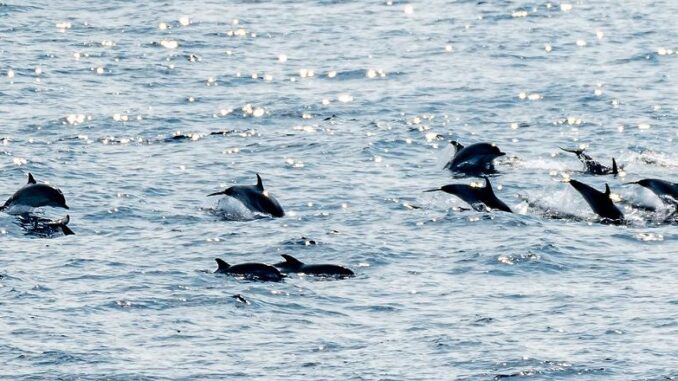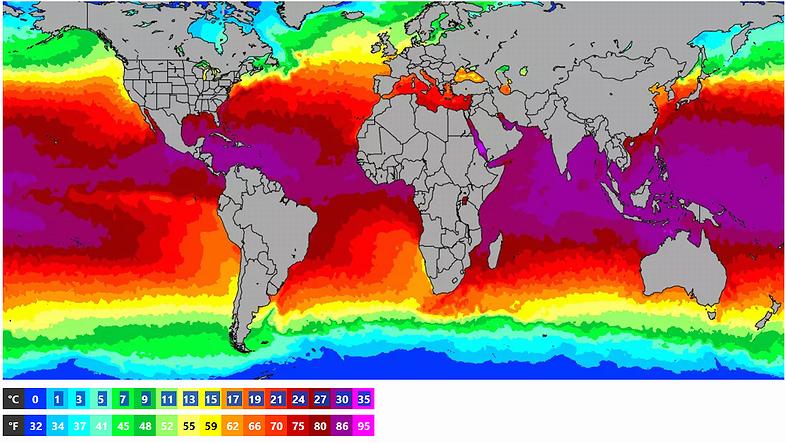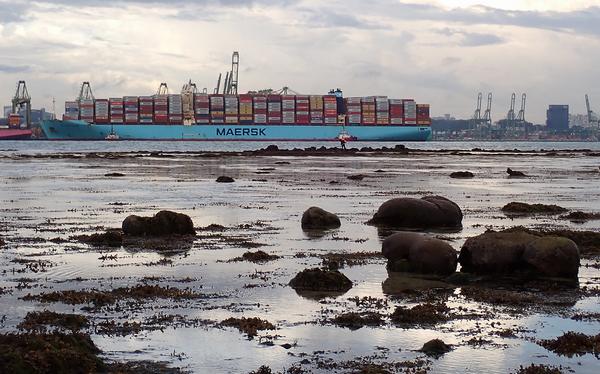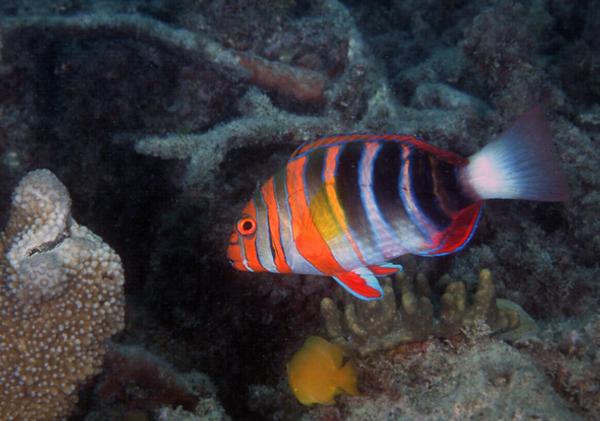
BEIJING, China, February 7, 2025 (ENS) – Ocean warming in 2024 has produced the hottest ocean temperatures ever recorded by humans, hot not only at the surface but also for the upper 2,000 meters (1.24 miles) of water depth.
These facts have emerged from the work of 54 scientists from seven countries, including the United States, led by Professor Lijing Cheng with the Institute of Atmospheric Physics at the Chinese Academy of Sciences. “The broken records in the ocean have become a broken record,” he quipped with a smile, but with wholly serious intent.

Conclusions from the three international teams who collaborated on the project were consistent – the ocean is warming, and 2024 was a record. They recorded their findings in a study entitled “Sea Surface Temperatures and Deeper Water Temperatures Reached a New Record High in 2024,” published in January 2025 in the journal Advances in Atmospheric Sciences.
Record-setting Heat Gripped the Globe in 2024
Over the past 12 months, 104 countries have recorded their hottest land temperatures ever. Droughts, heat waves, floods, and wildfires have impacted Africa, Southern Asia, the Philippines, Brazil, Europe, the United States, Chile, and Australia’s Great Barrier Reef, as just but a few examples.
On January 10, the World Meteorological Organization confirmed that 2024 was the planet’s warmest year on record, based on six international datasets. The past 10 years have all been in the Top Ten, in what the WMO called :an extraordinary streak of record-breaking temperatures.”
We have likely seen the first calendar year with a global mean temperature of more than 1.5°C above the pre-industrial average, the scientists warn. This 1.5°C target is a major goal of the Paris Agreement, a legally-binding treaty that took effect in 2016 after near unanimous approval by nations.
President Donald Trump has begun the lengthy process of again pulling the United States out of the Paris Agreement as he did during his first term (2017-2021). Under President Joe Biden, the United States rejoined the treaty.
Trump is also doing all that he can to dismantle the climate efforts of previous administrations, even though climate change has been expensive for the country. Since 1980, climate disasters have cost the United States alone nearly US$3 trillion.
Professor Cheng’s work includes study of historical ocean heat content change and Earth’s energy budget. He was a lead author of the United Nations – Intergovernmental Panel on Climate Change (IPCC) Special Report for Ocean and Cryosphere; United Nations – World Ocean Assessment published in 2022.
That 2022 IPCC report makes clear exactly what climate risks the oceans now face and that human societies must now address. Click here to read the IPCC report.
“Evidence and understanding of the human causes of climate warming, and of associated ocean and cryosphere changes, has increased over the past 30 years of IPCC assessments,” the IPCC explained with “very high confidence.”
“Human activities are estimated to have caused approximately 1.0°Celsius of global warming above pre-industrial levels. Areas of concern in earlier IPCC reports, such as the expected acceleration of sea level rise, are now observed,” the IPCC report states with “high confidence.”
“Significant sea level rise contributions from Antarctic ice sheet mass loss, which earlier reports did not expect to manifest this century, are already being observed,” the IPCC warned, again with very high confidence.
That 2022 report contains several jarring warnings.
- – “Characteristics of ocean and cryosphere change include thresholds of abrupt change, long-term changes that cannot be avoided, and irreversibility,” the IPCC reported with “high confidence.” Ocean warming, acidification and deoxygenation, ice sheet and glacier mass loss, and permafrost degradation are expected to be irreversible on time scales relevant to human societies and ecosystems.”
- – “Societies will be exposed, and challenged to adapt, to changes in the ocean and cryosphere even if current and future efforts to reduce greenhouse gas emissions keep global warming well below 2°Celsius,” the IPCC report states.
- – The scale and cross-boundary dimensions of changes in the ocean and cryosphere challenge the ability of communities, cultures and nations to respond effectively within existing governance frameworks. Profound economic and institutional transformations are needed if climate-resilient development is to be achieved.
“Changes in the ocean and cryosphere, the ecosystem services that they provide, the drivers of those changes, and the risks to marine, coastal, polar and mountain ecosystems, occur on spatial and temporal scales that may not align within existing governance structures and practices. This report highlights the requirements for transformative governance, international and transboundary cooperation, and greater empowerment of local communities in the governance of the ocean, coasts, and cryosphere in a changing climate,” according to the IPCC report.

Newest Report Documents Hot Oceans
The scientists explain that the oceans dictate our weather patterns by transferring heat and moisture into the atmosphere.
The oceans also control how fast climate change happens. “To know what is happening to the climate, the answer is in the ocean,” co-author Professor John Abraham, mechanical engineering professor at the University of St. Thomas School of Engineering in Minnesota, said.
What happens in the Pacific Ocean is especially important to Minnesota, said Abraham, a thermal-science expert and one of the lead scientists of the study.
“That’s because our weather comes from west to east,” Professor Abraham said. “As the atmosphere passes over the Pacific, it will pick up moisture and heat, and then it releases that moisture and heat over a place like Minnesota.”
In 2024, ocean temperatures soared past the prior record set in 2022 by nearly 0.5 degrees Fahrenheit, spurred by both climate change and a strong El Niño.
The term El Niño, which is Spanish for the Christ Child, refers to a warming of the ocean surface, or above-average sea surface temperatures, in the central and eastern tropical Pacific Ocean.
The low-level surface winds, which normally blow from east to west along the equator, instead weaken or, in some cases, start blowing the other direction, from west to east. El Niño recurs irregularly, from two years to a decade, and no two events are exactly alike. El Niño events can disrupt normal weather patterns in the United States and globally.
La Nina refers to the periodic cooling of ocean surface temperatures in the central and eastern tropical Pacific Ocean. Typically, La Nina events occur every three to five years, but on occasion can occur over successive years. La Nina represents the cool phase of the El Nino/Southern Oscillation (ENSO) cycle.
Surface temperatures are important because they dictate how fast heat and moisture can transfer from the ocean to the air and affect weather. “The rise in surface temperatures since the late 1950s has been staggering,” the ocean temperature scientists said.
While parts of the Northern Pacific Ocean have warmed very rapidly, other areas, such as the tropical region, have not, mostly due to the La Nina/El Nino cycle in that area. The heat has even accumulated near both the North and South Poles.
Ocean Surfaces Hotter Than Ever
The ocean surface temperature, where ocean waters and the atmosphere meet, is also setting records.

The changes are not uniform; regional variations can be substantial. The Atlantic is warming along with the Mediterranean Sea, and across the mid-latitude Southern Ocean.
A warmer ocean affects marine life and results in great damage in many ways.
Dr. Kevin Trenberth, a senior scientist at the U.S. National Center for Atmospheric Research, another member of Professor Cheng’s ocean temperature team, explained, “The main way the ocean continues to influence the climate is through accompanying increases in water vapor in the atmosphere that leads to the damaging increases in extremes in the hydrological cycle.”
“Water vapor is also a powerful greenhouse gas and increased heating leads to drying and risk of drought and wildfire. But it also fuels storms of all sorts and leads to risk of flooding. That includes hurricanes and typhoons,” Dr. Trenberth said.
The heat in the ocean is the best measurement for monitoring the changing climate.
“The ocean is our sentinel for planetary warming, acting as the major sink of surplus heat accumulating in Earth climate system as a result of anthropogenic emissions” co-author Dr. Karina von Schuckmann at Mercator Ocean International in Toulouse, France, said. “If there continues to be a failure to take action to slow climate change, the disruption, unprecedented change and its implications, costs and loss and damages will continue to increase.”
A Note of Hope for the Great Barrier Reef
On the east coast of Australia marine scientists at James Cook University, JCU, study the effects of ocean warming on the Great Barrier Reef, the planet’s largest.

In October 2022, a team of scientists from JCU and the Australian Institute of Marine Science, AIMS, found that some coral species can adapt to increasing temperatures that cause bleaching, but only when marine heat wave events remain mild.
Dr. Hugo Harrison, a senior research fellow at JCU and AIMS, is the lead of this study of adaptation to climate warming found in the corals of the Coral Sea Marine Park in partnership with Parks Australia.
“Corals in this region regularly experience marine heatwaves, where they are exposed to temperatures near, or above, their upper limits,” Dr. Harrison said. “We wanted to test if reefs exposed to more frequent heatwaves in the past have developed enhanced capacity to withstand these events in the future. And this is exactly what we found.”
Featured image: Dolphins head north in the Bay of Biscay along the coasts of France and Spain in the northeast Atlantic Ocean. August 29, 2018 (Photo by Rab Lawrence)



